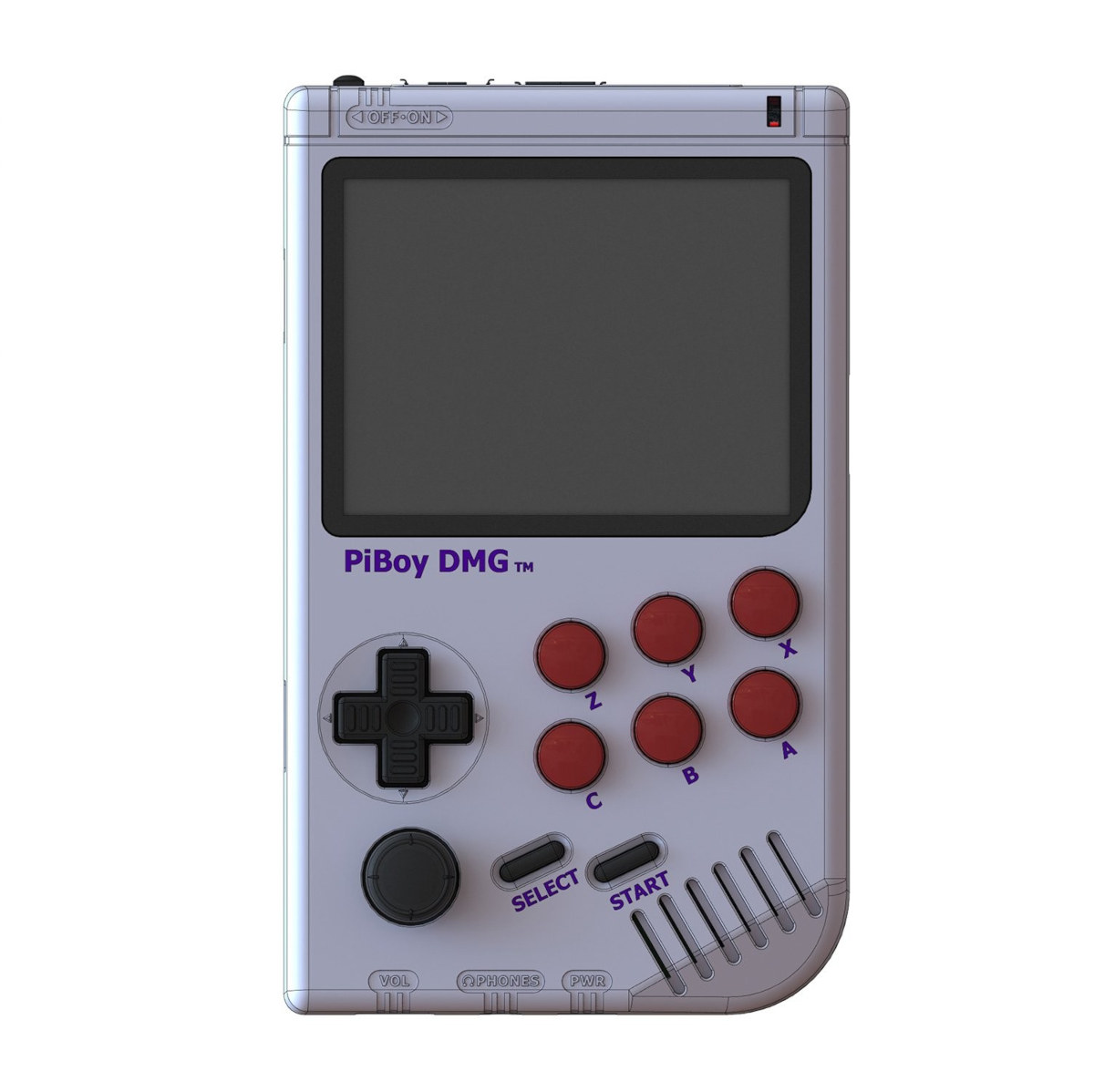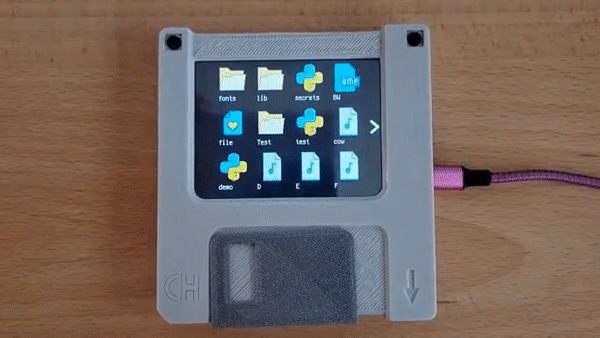Experimental Pi’s PiBoy DMGxis is a kit that converts the Raspberry Pi 5 into a handheld gaming console that looks like a Game Boy with a 3.5-inch color display and all the controls found on the original Game Boy. The company has launched several PiBoy portable game console kits for Raspberry Pi SBCs over the years, so the new PiBoy DMGx for the Raspberry Pi 5 should come as no surprise, and the company says it should be able to run emulators for N64, PSP, Dreamcast, Wii, Gamecube, PS2, and others. PiBoy DMGx kit specifications: Supported SBCs – Raspberry Pi 5; with adapters: Raspberry Pi 3 and 4 Storage – MicroSD card slot (11) Display – 3.5-inch display with 640 x 480 resolution (3) Video Output – Micro HDMI port from RPi 5 Audio – Speaker (5), 3.5mm audio jack (7) User inputs – D-Pad (10), analog stick (9), […]
Vivid Unit is a low-profile Rockchip RK3399 SBC with an integrated touchscreen display
UUGear’s Vivid Unit is a low-profile SBC with an integrated 5.5-inch 1280×720 touchscreen display powered by the older Rockchip RK3399 hexa-core Cortex-A72/A53 SoC coupled with 4GB RAM and a 32GB eMMC flash. The board also comes with gigabit Ethernet and WiFi 4 connectivity, supports M.2 NVMe storage, offers HDMI output and a MIPI CSI camera input, integrates a speaker and a stereo microphone, and allows for expansion through a 40-pin GPIO header and other headers for ADC and USB. Vivid Unit specifications: SoC – Rockchip RK3399 CPU – Hexa-core big.LITTLE processor with 2x Arm Cortex-A72 cores up to 1.8GHz, 4x Arm Cortex-A53 cores up to 1.4GHz GPU – Arm Mali-T860MP4 GPU AI accelerator – 6 TOPS NPU System Memory – 4GB LPDDR4 Storage 32GB eMMC flash M.2 socket for NVMe SSD Display – 5.5-inch touchscreen display with 1280×720 resolution Video Output – HDMI port Camera Input – MIPI CSI camera […]
CERBERUS 2100 is a BASIC-programmable educational board with Z80 and 6502 8-bit CPUs
Olimex has just announced the launch of the CERBERUS 2100 open-source hardware, educational, multi-processor 8-bit computer with both Z80 and 6502 CPUs, as well as a Microchip AVR processor serving as an I/O controller. The CERBERUS 2100 features several CPLD and is fully programmable from the lowest level (individual gates and flip-flops) up to BASIC interpreters running on the Z80 and 6502 CPUs. Olimex did not design this themselves as the hardware design is from Bernardo Kastrup (aka TheByteAttic), while BASIC interpreters were written by Alexander Sharikhin (6502) and Dean Belfield (Z80). CERBERUS 2100 specifications: Processors Zilog Z80 8-bit microprocessor at 4 or 8 MHz (user selectable) Western Design Center W65C02S 8-bit microprocessor at 4 or 8 MHz (user selectable) “FAT-CAT” (Custom ATmega328pb) Microchip 8-bit AVR ATMega328PB microcontroller at 16 MHz CPLDs (ATF1508AS-7AX100) FAT-SCUNK (Scan CoUNter and clocK) and FAT-CAVIA (ChAracter Video Adapter) for video circuit connected to a 25.175 […]
Sipeed Tang Primer 25K board features 23,040 Logic Cells for FPGA prototyping and development
Sipeed has recently introduced the Tang Primer 25K, an FPGA board powered by Gowin Semi GW5A-LV25MG121 chip. This board features 23,040 LUTs, USB Host capability, and an optional SDRAM module that unlocks vintage gaming. We have previously covered many FPGA boards like Sipeed Tang Mega 138K Pro, Fudan Micro JFM7K325T, ILYGO T-FPGA, and many other development boards by Sipeed including the Sipeed Tang Nano 20K with a Gowin GW2A FPGA. You can check those out if interested. The Tang Primer 25K development board is divided into the 25K SoM Board and the 25K Dock Board together they offer a comprehensive set of features: GW5A-LV25MG121 specifications: 23040 LUT4 23040 Registers (FF) 28x 18×18 Multipliers 6x PLLs Memory/Storage: 64Mbit NOR Flash 180K Distributed S-SRAM 1008K B-SRAM (bits) 56 Number of B-SRAM I/O Interfaces: 3x PMOD 40-pin header 2x buttons 8x I/O banks 75x General IO MIPI IO – 4lane Data USB Ports: […]
Olimex ESP32-SBC-FabGL board runs DOS, offers VGA , PS/2 keyboard and mouse connectors
Olimex ESP32-SBC-FabGL is an ESP32 single board computer that can serve as the brain of a retro computer with a VGA port, a 3.5mm audio jack, and two PS/2 ports for a keyboard and mouse that are handled by the open-source FabGL graphics library. The board also comes with a microSD card slot, a buzzer, and various expansion interfaces, and can be powered via its USB port or a LiPo battery. FabGL implements several emulators including an Intel 8080 CPU emulator that allows the system to run various versions of DOS among other things. ESP32-SBC-FabGL specifications: Wireless module – ESP32-WROVER dual-core WiFi and Bluetooth module with 4MB flash, 8MB PSRAM Storage – MicroSD card slot Display – VGA connector, 12-pin LCD HAT connector to enable handheld designs Audio – 3.5mm audio jack, built-in buzzer USB – 1x USB-C port for power and programming User inputs – PS2 keyboard connector, PS2 […]
Floppy thumb drive integrates Adafruit PyPortal display based on Microchip SAMD51 MCU
Anne Barela’s Floppy Thumb Drive project houses the Adafruit PyPortal internet display in a 3D-printed enclosure that looks like a 3.5-inch floppy disk, just a bit thicker. The computer-in-a-floppy-disk project runs CircuitPython code to list the first 12 files stored in the flash and can display photos or animations, play audio, or execute scripts. The project consists of three main parts: The Adafruit PyPortal internet display with Microchip SAMD51 (ATSAMD51J20) Arm Cortex-M4F microcontroller @ up to 120 MHz with 1 MB flash, 256 KB SRAM Display – 3.2-inch 320 x 240 color TFT display with resistive touchscreen Audio – Speaker Storage 8MB flash storage optional microSD card (not used in the project). ESP32 for WiFi and Bluetooth connectivity (not used in the project) Sensors – Light and Temperature sensors Misc – NeoPixel RGB Micro USB to USB cable 3D printed files for the front cover, back door, front door, disk, […]
Auspicious Machine modular handheld Linux PC with keyboard takes various Arm-based SoMs
The “Auspicious Machine” may look like a Blackberry phone, but it’s actually a handheld Linux PC with a built-in QWERTY keyboard and a 3.5-inch display that can be powered by a range of system-on-modules (SoM). The computer, whose name can also be translated as the “Auspicious Phone”, can be used as a Linux terminal with GPIO control, and for gaming with Linux distributions such as Batotera or RetroBat with the D-Pad and ABXY buttons found on the device. Auspicious Machine specifications: Supported SoMs Bigtreetech CB1 with Allwinner H616 quad-core Cortex-A53 processor and 1GB DDR4 Raspberry Pi CM4 with Broadcom BCM2711 quad-core Cortex-A72 processor, up to 8GB LPDDR4, up to 32GB eMMC flash Radxa CM3 with Rockchip RK3566 quad-core Cortex-A55 processor, up to 4GB LPDDR4, up to 64GB eMMC flash Banana Pi BPI-CM4 with Amlogic A311D octa-core Cortex-A73/A55 processor with 4GB LPDDR4 and 16GB eMMC flash Storage – MicroSD card socket […]
Raspberry Pi 400 powers dual-display retro-gaming console
“Block after Block” has designed a dual-display tabletop retro-gaming console using plywood edge grain and a Raspberry Pi 400 keyboard PC that allows players to physically face each other during a fight or other gameplay. While there’s a galore of projects based on Raspberry Pi SBCs, the Raspberry Pi 400 keyboard PC is more like a consumer product due to its form factor, but Block after Block integrated the PC into its own retro-gaming console which involved a lot of woodworking skills and installing RetroPie on the Pi 400 device. This DIY project mostly involves spending time in a workshop cutting wood, and once you’re done with this part, it should be pretty straightforward. The following items are required for the project: A Raspberry Pi 400 keyboard PC Two monitors (second-hand monitors will do) An HDMI splitter to mirror the output from the Pi 400 along with a micro HDMI […]










